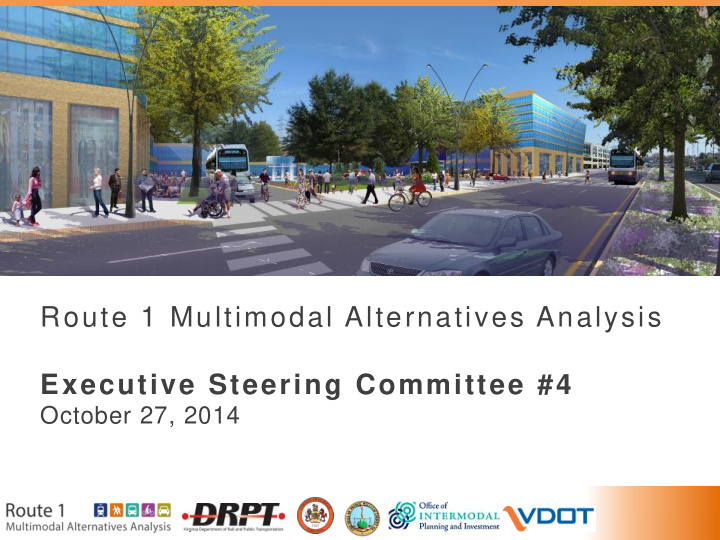



Route 1 Multimodal Alternatives Analysis Executive Steering Committee #4 October 27, 2014
Agenda 1. Public Meeting #3 summary 2. Final project recommendations 3. Potential implementation timeline revisions 4. Project action items 5. Next steps − Transportation Project Development − Planning Initiatives − Adoption into local and regional plans 6. Resolution 2
Public Meeting #3 Meeting Format: • Open House (Boards) • Presentation • Moderated Q&A • Boards, Discussion • Activity: Survey, Talk with Project Team Members Attendance Meeting 1- Prince William County (Oct 8): • 49 attendees • 13 completed surveys Meeting 2 - Fairfax County (Oct 9): • 103 attendees • 51 completed surveys 3
Public Meeting #3: Key Themes and Survey Results • Majority of residents generally support draft recommendation • Want to expedite Metrorail extension • Interested in learning more about County land use planning and transit modes • Recognize project funding is biggest challenge 4
Draft Recommendations Evaluation results suggest: • Median running Bus Rapid Transit (BRT) would provide a near-term cost-effective transportation solution to support economic development plans. • Metrorail extension to Hybla Valley would provide a higher level of local and regional mobility and support long-term corridor development, contingent upon increased future land use density. 5
Phasing Approach Phase I-III: Implement Phase IV: Extend Metrorail Multimodal to Hybla Valley, contingent Improvements and BRT upon future land use (Median Running) 3.1 mi. 3.1 mi. 7.3 mi Note: contingent upon 4.6 mi. future land use 6
Final Project Recommendations Phased implementation of the multimodal investments of Alternative 4- BRT/Metrorail Hybrid, including: • Roadway Widening : Widen roadway from four lanes to six lanes where necessary to create a consistent, six-lane cross section along the corridor • Bicycle and Pedestrian Facilities: Create a continuous facility for pedestrians and bicyclists along the 15 mile corridor; the configuration will vary depending upon urban design, right-of-way availability, and other local considerations • Transit: Implement a median-running Bus Rapid Transit (BRT) system from Huntington to Route 123 in Woodbridge (curb-running BRT in mixed traffic within the Prince William County portion) and a 3-mile Metrorail Yellow Line extension from Huntington to Hybla Valley as expeditiously as possible, contingent upon increased land use density and project funding 7
Potential Implementation Timelines Years (2015-2040) 15 16 17 18 19 20 21 22 23 24 25 26 27 28 29 30 31 32 33 34 35 36 37 38 39 40 Phase I: Huntington to Hybla Valley + Roadway Widening Roadway Widening and Bike/Ped, BRT Market Absorption Study Phase I Comprehensive Plan Revisions Phase II: Hybla Valley to Fort Belvoir BRT and Bicycle/Pedestrian, BRT Market Absorption Study Phase II Comprehensive Plan Revisions Phase III: Fort Belvoir to Woodbridge Improvements Roadway Widening and Bike/Ped Market Absorption Study Phase III Comprehensive Plan Revisions * PhaseIV: Huntington to Hybla Valley Metrorail Extension Metrorail Market Absorption Study Phase IV Comprehensive Plan Revisions Note: Timelines assume a funding stream to support projects implementation. *Contingent upon increased future land use density. Legend: General Project Development Sequence Comprehensive Planning Scoping/ Final Design Right of Way Utilities Construction Operation Plan NEPA PE Relocation Typical New Starts Funding Steps/Sequence: FTA SMALL STARTS PROJECT DEVELOPMENT PROCESS FTA NEW STARTS PROJECT DEVELOPMENT PROCESS 8
Project Action Items 1. Transmit study results to local governments for endorsement and implementation 2. Begin to incorporate recommendations in local, regional, and state plans: • County Comprehensive Plans and Capital Improvement Programs • NVTA TransAction 2040 Plan and 6-Year Program • MWCOG Constrained Long Range Plan and Transportation Improvement Program • Virginia Statewide Transportation Plans and 6-Year Program 3. Identify immediate next steps and responsible parties 4. Identify immediate next steps associated with BRT implementation and land use evaluation 9
Next Steps: Transportation Project Development 1. Develop more detailed funding plan 2. Identify Project Sponsor(s) 3. Request class of action determination from FTA and FHWA 4. Initiate environmental documentation for Phases I and II (Huntington to Fort Belvoir) 10
Next Steps: Planning Initiatives 1. Comprehensive Plan Amendment Update – Infrastructure requirements due to increased land use density (roads, schools, etc.) – Refined street cross sections and corridor design standards – BRT stop locations 2. Market Absorption Study: understand rate of growth anticipated in and to the corridor 3. Right of Way Survey: Route 1 will need a survey performed to confirm potential impacts during the environmental review phase 4. Continue involvement and engagement with business owners and economic development stakeholders 11
Complete Current Study • Consultant Team: – Finalizing Alternatives Analysis Final Report – Posting project documents on project website • Executive Steering Committee: – Endorses study findings – Sends study for action by County Boards 12
Action Plan for Implementation 13
Resolution Issued by Executive Steering Committee, which has coordinated regularly with the study team through 15 months of work. Summarizes outcomes and recommendations: • Multimodal (roadway, bicycle/pedestrian, and transit) investments of “Alternative 4 BRT/Metrorail Hybrid” • Include the recommendations in local, regional, and statewide funding plans • Plan for supportive land uses and infrastructure 14
Recommend
More recommend